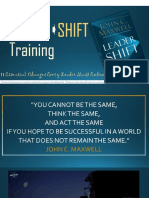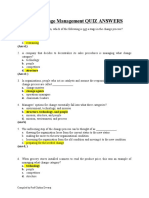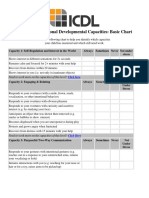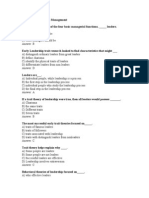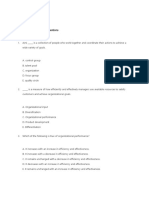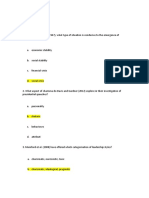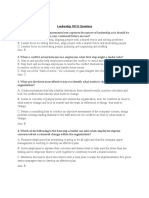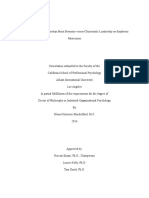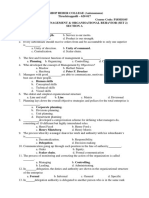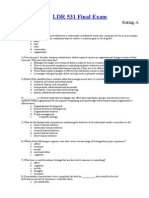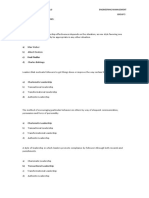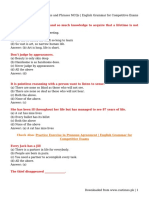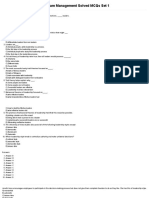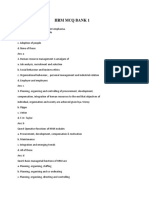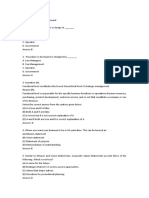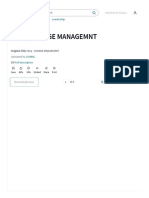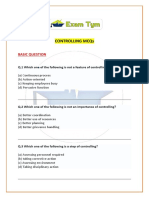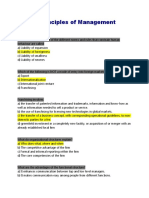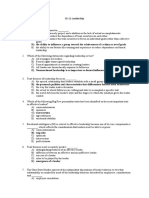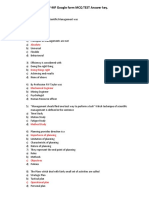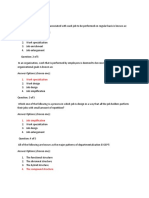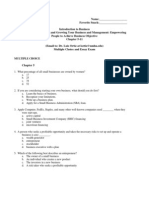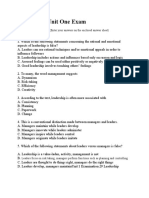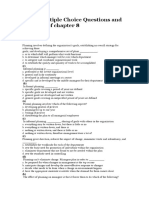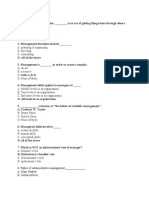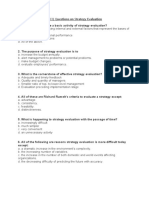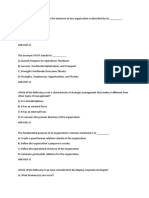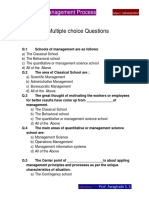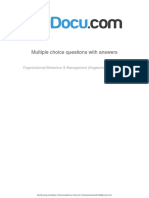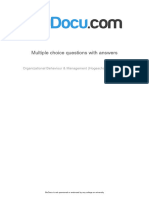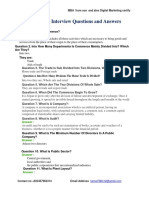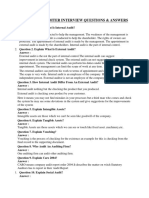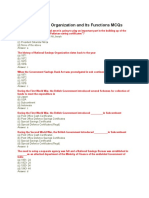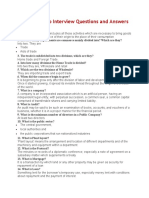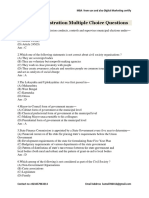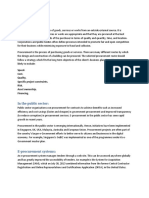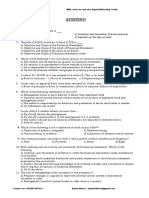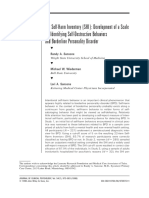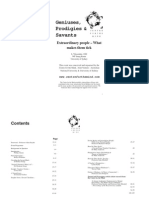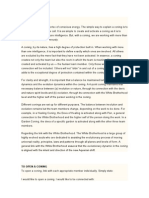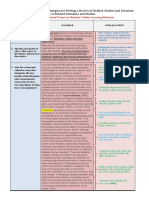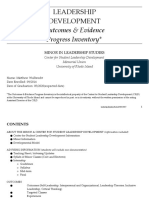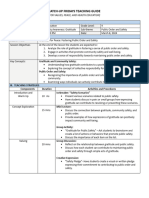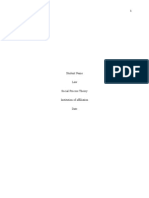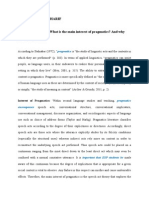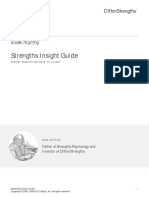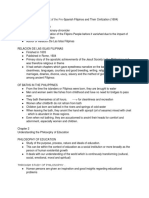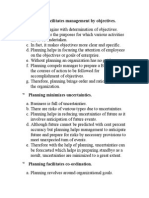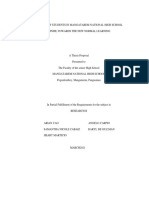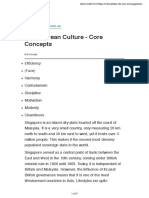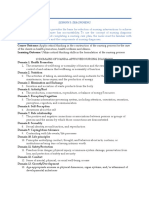Multiple Choice Questions With Answers
Multiple Choice Questions With Answers
Uploaded by
kamal sahabCopyright:
Available Formats
Multiple Choice Questions With Answers
Multiple Choice Questions With Answers
Uploaded by
kamal sahabOriginal Description:
Copyright
Available Formats
Share this document
Did you find this document useful?
Is this content inappropriate?
Copyright:
Available Formats
Multiple Choice Questions With Answers
Multiple Choice Questions With Answers
Uploaded by
kamal sahabCopyright:
Available Formats
lOMoARcPSD|1167492
Multiple choice questions with answers
Organizational Behaviour & Management (Hogeschool Rotterdam)
StuDocu is not sponsored or endorsed by any college or university
Downloaded by kamal sahab (kamal786412@gmail.com)
lOMoARcPSD|1167492
Chapter 1.
1. The everyday tasks of management include:
A. planning and creativity
B. planning and leading
C. publicity and loss adjustment
D. plotting and leading
2. The main schools of management thought are:
A. classical, human resources, systems, contingency
B. classical, human resources, systems, contextual
C. classical, human relations, systems, contingency
D. creative, human relations, systems, contingency
3. "It all depends on the variables of a situation" best describes the
A. classical approach
B. human relations approach
C. systems approach
D. contingency approach
4. The observation of people at work that would reveal the one best way to do a task is known
as
A. scientific management
B. classical management
C. human relations management
D. creative management
5. The founder of scientific management was
A. Frederick Taylor
B. Henri Fayol
C. Elton Mayo
D. Chester Barnard
6. The first management principles were developed by
A. Frederick Taylor
B. Charles Handy
C. Henri Fayol
D. Victor Meldrew
7. Studying the future and arranging the means for dealing with it is part of the process of
A. organising
B. commanding
C. controlling
D. planning
8. Ensuring that everything is carried out according to plan is part of the process of
Downloaded by kamal sahab (kamal786412@gmail.com)
lOMoARcPSD|1167492
A. planning
B. controlling
C. organising
D. co-ordinating
9. "Division of work, authority and responsibility, unity of command" were proposed as part of
the fourteen principles of management by
A. Weber
B. Fayol
C. Taylor
D. Woodward
10. Bureaucracy theory was proposed by
A. Weber
B. Fayol
C. Taylor
D. Handy
11. Bureaucracy theory means
A. the development of management functions and administrative principles
B. a scientific study of work
C. a shared responsibility of authority and delegation
D. a hierarchy of command based on a rational-legal authority structure
12. The Hawthorne experiments were conducted by
A. Elton Mayo
B. Max Weber
C. Charles Handy
D. Henri Fayol
13. The unintentional biasing of research outcomes due to the possibility that simply paying
attention to the experimental subjects causes their behaviour to change is known as the
A. Mayo effect
B. Cause and effect
C. Hawthorne effect
D. Law and effect
14. Who defined human motivation as "the study of ultimate human goals
A. Weber
B. Maslow
C. Taylor
D. Fayol
15. The analysis of a manager as a social systems approach was proposed by
A. Chester Barnard
B. Elton Mayo
Downloaded by kamal sahab (kamal786412@gmail.com)
lOMoARcPSD|1167492
C. Henri Fayol
D. Max Weber
16. "The whole is greater than the sum of the parts and that the parts or subsystems are related
to each other and to the whole" are emphasised in
A. Motivation theory
B. Contingency theory
C. Systems theory
D. Administrative theory
17. The study of organisational behaviour includes
A. diplomacy, scientology, psychology
B. sociology, psychology, anthropology
C. socioeconomics, philosophy, anthropology
D. physiology, society, anthropology
18. The use of theory to guide systematic, empirical research from which generalisations can be
made to influence applications is known as
A. social science approach
B. scientific management approach
C. open systems approach
D. scientific method
19. An in depth study on a single organisation using a variety of data collection methods is known
as
A. case study
B. field survey
C. field experiment
D. laboratory experiment
20. The method of research that gathers data about perceptions, feelings, opinions through
interviews and questionnaires in their actual work setting is known as
A. case study
B. field survey
C. field experiment
D. laboratory experiment
21. Control of independent variable manipulation without intervening environmental effects is at
its maximum in
A. case studies
B. field surveys
C. field experiments
D. laboratory experiments
22. Experiments that allow the researcher to manipulate independent variables in actual
organisations in an attempt to control variables and explain causality are known as
A. case studies
Downloaded by kamal sahab (kamal786412@gmail.com)
lOMoARcPSD|1167492
B. field surveys
C. field experiments
D. laboratory experiments
23. A statement about the proposed relationship between independent and dependent variables
is known as a
A. hypothesis
B. relationship
C. variable
D. hypotenuse
24. The variable thought to affect one or more dependent variables is known as
A. transient variable
B. independent variable
C. dependent variable
D. intransient variable
25. The outcome studied through research and believed to be caused or influenced by an
independent variable is known as
A. transient variable
B. independent variable
C. dependent variable
D. intransient variable
26. A variable believed to influence the effects of the independent variable on the dependent
variable is known as
A. independent variable
B. dependent variable
C. moderating variable
D. reliable variable
27. The consistency of data obtained from a particular research method is known as
A. reliability
B. validity
C. credibility
D. causality
28. The degree to which a research method actually measures what it is supposed to measure is
known as
A. reliability
B. validity
C. credibility
D. causality
29. The acceleration of technology that affects work processes is influenced by
A. internal forces
Downloaded by kamal sahab (kamal786412@gmail.com)
lOMoARcPSD|1167492
B. social forces
C. national forces
D. external forces
30. The transforming effect on how we work, live, communicate and travel is influenced by
A. technology
B. diversity
C. ethics
D. globalisation
31. TQM refers to
A. total quarterly management
B. total qualifying management
C. total quality measurement
D. total quality management
32. JIT refers to
A. jump in too
B. jumps in technology
C. just in time
D. justify in technology
33. The process of continuous quality improvement in management refers to
A. JIT
B. TQM
C. IBM
D. ERM
34. The positive action to ensure that people are given fair opportunities to be hired in
organisations regardless of ethnicity, gender or age is known as
A. affirmative action
B. discrimination
C. race relations
D. progressive practices
35. Acting ethically in business
A. is immoral
B. reduces profits
C. leads to bad decisions
D. promotes long term benefits
36. The study of organisational behaviour mainly involves the study of
A. individuals and groups
B. buildings
C. structures
D. departments
Downloaded by kamal sahab (kamal786412@gmail.com)
lOMoARcPSD|1167492
37. Managing the human resource is
A. the smallest department in an organisation
B. better managed outside the organisation
C. vital for the success of an organisation
D. an unnecessary expense
38. The social and technical integration of the Human Relations and classical school is known as
the ____________ approach.
A. classical
B. human relations
C. systems
D. contingency
39. A method of helping is to understand management and organisational behaviour is to look at
_________ that has been done before
A. experiments
B. research
C. management
D. behaviour
40. Fayol elevated the study of management from the shop floor to the
A. people
B. managers
C. customers
D. organisation
41. Designing a structure to assist in goal accomplishment is known as
A. planning
B. organising
C. co-ordinating
D. commanding
42. The principle of management that proposes that "there should be a line of authority from
highest to lowest is known as
A. order
B. unity of direction
C. scaler chain
D. unity of command
43. Impersonal treatment of people through consistent application of rules and decisions to
prevent favouritism is part of
A. equity theory
B. motivation theory
C. leadership theory
D. bureaucracy theory
Downloaded by kamal sahab (kamal786412@gmail.com)
lOMoARcPSD|1167492
44. The act of co-operation lease to the establishment of co-operative systems was proposed by
A. Barnard
B. Fayol
C. Maslow
D. Taylor
45. The reciprocal nature of power was articulated by
A. Barnard
B. Follett
C. Fayol
D. Taylor
46. The social science discipline that focuses directly on understanding and predicting individual
behaviour is known as
A. psychology
B. sociology
C. anthropology
D. political science
47. The social science that studies how individuals interact with one another in social systems is
know as
A. psychology
B. sociology
C. anthropology
D. political science
48. The behavioural science hybrid that integrates psychology and sociology is known as
A. psysology
B. psycho sociology
C. social psychology
D. socpsycology
49. One type of organisation especially buffeted by technological change is
A. the medium tech firm
B. the no tech firm
C. the low tech firm
D. the high tech firm
50. People who work in the Human resource department should have a knowledge of
A. organisational behaviour
B. IT
C. Finance
D. marketing
Downloaded by kamal sahab (kamal786412@gmail.com)
lOMoARcPSD|1167492
Chapter 2
1. What must entrepreneurs and leaders learn in order to have a successful organisation?
A. How to control people and manipulate organisational systems.
B. How to think strategically, influence people, develop organisational systems.
C. How to manage technical details and use current business jargon.
D. How to read balance sheets and income statements.
2. Organisational success in providing a service or a product depends on
A. doing product development faster than anyone else.
B. being the cheapest in the market.
C. having the first product or service in the market place.
D. the product or service being valued by a segment of society.
3. The McDonalds restaurant chain was created to provide fast access to prepared food of
consistent quality, at reasonable prices, in a clean and cheerful eating environment. This
exemplifies:
A. An organisation being created to serve the needs of a particular customer segment or
group of people.
B. How an organisation can influence customers to buy its products.
C. The principle that demand can be created if an organisation is just persistent enough.
D. The fact that service organisations need not concern themselves with customer needs to
the extent that product manufacturers must.
4. Which of the following typifies an organisation?
A. The First National Bank.
B. The United Methodist Church.
C. The Local Primary School
D. All of the above.
5. According to Peter Drucker, where does the purpose of a business organisation find its
meaning?
A. With top management.
B. In each and every employee.
C. Within the organisational culture.
D. Outside the organisation.
6. Which must be accomplished first by the entrepreneur or leader?
A. The design of a rational organisation structure.
B. Generating profits.
C. Making viable the concept for which the organisation was founded.
D. Establishing policies that assure consistency of activities.
7. An organisation's mission is
A. the fundamental purpose of an organisation.
Downloaded by kamal sahab (kamal786412@gmail.com)
lOMoARcPSD|1167492
B. articulated in such a way that it defines the business of the enterprise.
C. a concept for unifying the efforts of organisational members.
D. all of the above.
8. A well-framed mission statement
A. defines specific performance objectives for the organisation.
B. delineates which managers are responsible for what activities.
C. gives direction to a sense of purpose.
D. defines the core technology on which the organisation is dependent.
9. The highest level of striving for the organisation is articulated by __________.
A. superordinate goals
B. operational strategies
C. functional policies
D. standard operating procedures
10. When the chief executive officer of Hewlett-Packard explains to employees that the viability
of the company depends on their continuing to improve and develop new products, she is
articulating a:
A. Superordinate goal.
B. Behavioural threat.
C. Mission statement.
D. Functional strategy.
11. Definable groups of people who have an economic and/or social interest in the organisation
are called
A. employees.
B. managers.
C. stakeholders.
D. linking pins.
12. To business firms, the Environmental Protection Agency is an example of what type of
organisation?
A. A vendor.
B. A regulator.
C. A controller.
D. A shareholder.
13. Which of the following is a system?
A. An organisation.
B. An automobile.
C. A toilet.
D. A community.
14. The Red Cross is essentially what type of system?
Downloaded by kamal sahab (kamal786412@gmail.com)
lOMoARcPSD|1167492
A. Efficient.
B. Social.
C. Legalistic.
D. Benevolent.
15. Systems that operate without interference from outside their boundaries are called
__________ systems.
A. isolated
B. mechanistic
C. structured
D. closed
16. A corporate lawyer negotiating with a government agency regarding compliance with an
existing law is an example of a professional working for an organisation that is
A. a closed system.
B. an efficient system.
C. an open system.
D. a regulated system.
17. The rational heroic view of what managers (as planners, organizers, etc.) owes its origins to
the early writings of:
A. Henri Fayol.
B. Peter Drucker.
C. Henry Mintzberg.
D. Adam Smith.
18. As opposed to closed systems, open systems
A. interact with the environment.
B. are more complex.
C. are more difficult to control.
D. All of the above.
19. The rational heroic manager plans, organizes, coordinates, and _________.
A. watches
B. reprimands
C. represents
D. controls
20. What interpersonal role is being performed by the manager who is awarding a gold watch to a
retiring employee?
A. Figurehead.
B. Liaison.
C. Spokesperson.
D. Disseminator.
Downloaded by kamal sahab (kamal786412@gmail.com)
lOMoARcPSD|1167492
21. Mintzberg's roles of figurehead, leader, and liaison are what he calls the ________ roles.
A. interpersonal
B. informational
C. decisional
D. None of the above.
22. When a manager makes a decision to convert production operations to a new technology,
which of Mintzberg's decisional roles is she performing?
A. Negotiator.
B. Resource allocator.
C. Disturbance handler.
D. Disseminator.
23. According to Mintzberg, into which role is the manager typically drawn involuntarily?
A. Entrepreneur.
B. Disturbance handler.
C. Resource allocator.
D. Negotiator.
24. The lower a manager is in the organisational hierarchy, the more important his/her _______
skills are.
A. human
B. conceptual
C. technical
D. interpersonal
25. From what root discipline(s) does the study of organisational behaviour borrow its core
concepts?
A. Psychology.
B. Sociology
C. Anthropology.
D. All of the above.
26. Organisational behaviour allows us to be more prepared to cope with the challenges of
modern management and life in organisations. What do the practical applications of
behavioural research tell managers?
A. Why humans are inherently ill-suited to the workplace.
B. How to improve the odds that their influence will be effective.
C. That common sense is the best guide for managers
D. How to program employees for peak performance through direct, precise application of
theoretical models.
27. Who would be most likely to use the roles of figurehead, spokesperson, and negotiator?
A. A sales manager.
B. A production manager.
Downloaded by kamal sahab (kamal786412@gmail.com)
lOMoARcPSD|1167492
C. A product development manager.
D. A first-line supervisor.
28. A manager redesigning a job to make it physically easier for workers to perform is an example
of transforming which key resource element?
A. Technology.
B. Tasks.
C. Organisational culture.
D. People.
29. Adding robotics to an assembly line is an example of transforming the resource element of
________.
A. tasks
B. organisational culture
C. people
D. technology
30. The five-variable model showing change options for using resource elements to transform
organisational systems is intended to
A. modify the structure of the real organisation.
B. eliminate the conflict in an organisation.
C. simplify the complexity of a real organisation to emphasize interconnected elements.
D. amplify the differences among organisational subsystems.
31. Governance policies, rules, as well as authority structures apply to which key resource
element of the organisation?
A. Technology.
B. Organisation.
C. Organisational culture.
D. People.
32. Productivity is a ratio of outputs (products or services) to ____________.
A. profits generated
B. sales price
C. inputs consumed
D. behaviour effectiveness
33. "Doing the right things" is referred to as ____________.
A. effectiveness
B. efficiency
C. productivity
D. profitability
34. Research indicates the correlation between job satisfaction and productivity is
_____________.
Downloaded by kamal sahab (kamal786412@gmail.com)
lOMoARcPSD|1167492
A. a cause and effect relationship
B. high
C. low
D. almost impossible to measure
35. Revitalization involves ________ the strategies, resources, technology, and skills of the
organisation.
A. focusing
B. categorizing
C. formalizing
D. renewing
36. What is the relationship between satisfaction and productivity, as suggested by research?
A. High satisfaction leads to high productivity.
B. Productivity does not influence satisfaction.
C. Moderate satisfaction results in low productivity.
D. Productivity often leads to satisfaction.
37. As social-technological-economic changes take on greater specificity four thematic issues
affect most managerial practices regardless of the industry. Which of the following is not such
an issue?
A. Global business.
B. Ethical behaviour.
C. Profit motive.
D. Human diversity.
38. During the last quarter of the 20th century, racial minorities and women made considerable
progress in gaining employment access into the corporate world. Therefore, the challenge for
the early 21st century is _________________________.
A. granting equal opportunities so that everyone is able to reach his/her full potential
B. guaranteeing entry to organisations at senior ranks
C. learning to accept the benefits of diversity
D. promoting diversity quotas at each level within organisations
39. Diversity in the workplace in the is
A. not a factor-immigrants are absorbed by the "melting pot" culture rather quickly.
B. stable and unlikely to increase.
C. accelerating.
D. declining faster than ever before in the nation's history.
40. Satisfaction is defined as positive feelings people have about an organisation whether as a/an
A. supplier, employee, customer, or regulator.
B. employer, customer, regulator, or supplier.
C. investor or stockbroker.
D. Neither A nor B.
Downloaded by kamal sahab (kamal786412@gmail.com)
lOMoARcPSD|1167492
41. What best describes the purchasing process for large military systems such as aircraft and
ships?
A. Unbiased cost-benefit analysis.
B. Compatibility of criteria among government departments and the contractors.
C. Careful selection of new designs based on improved performance.
D. Political compromises.
42. What is not characteristic of the work of a typical manager?
A. The workday is fragmented with a great variety of unrelated tasks.
B. Their most important communication is written, including reports and e-mail.
C. They spend much of their time reacting to unplanned issues and problems initiated by
others.
D. They often feel like a puppet with others pulling the strings, yet they move in their chosen
direction.
43. As a country in the global spotlight, Japan has undergone several stages of transformation
over the last 70 or so years, including strategies that can be labelled in sequence as
A. rebuild, export, and rebuild again.
B. agrarian, industrial, informational.
C. fight, export, buy.
D. take and fight, make and export, invest and build abroad.
44. What is the primary reason why you should study management and organisational
behaviour?
A. The chances are high you will spend much of your life working for or within organisations.
B. It is fun to learn why people often do dumb things in organisations and how to prevent
them.
C. The lessons of managerial success can be learned as seven basic habits of organisational
behaviour.
D. The fastest way to become rich is by working for a firm that provides generous stock
options.
45. Management is the practice of
A. recruiting and motivating talented people to work for your organisation.
B. increasing a firm's revenues and cutting costs to maximize profits.
C. directing, organizing, and developing people, technology, and financial resources.
D. mastering political behaviours so that the fittest survive and rise to the top.
46. What does a fire department, hospital, business, service club, and church all have in
common?
A. They all have shareholders.
B. They all are organisations.
C. They all are closed systems.
D. They all are growth oriented.
47. What is not common to the purpose of an organisation?
Downloaded by kamal sahab (kamal786412@gmail.com)
lOMoARcPSD|1167492
A. Working to benefit multiple stakeholders.
B. Using a mission and goals to focus purpose.
C. Having first-line managers create superordinate goals.
D. Organizing around ways of serving customers/clients.
48. As a dynamic system, an organisation can do everything except
A. change over time.
B. redesign its compensation policy.
C. restructure its sources of financing.
D. close off its boundaries to outside disturbance.
49. Managers are typically integrators of
A. people.
B. tasks.
C. technology.
D. All of the above.
50. Productivity ultimately depends on both
A. efficiency and effectiveness.
B. infrastructure and culture.
C. people and money.
D. satisfaction and revitalization.
Downloaded by kamal sahab (kamal786412@gmail.com)
lOMoARcPSD|1167492
Chapter 3
1. What is planning?
A. The process of establishing objectives and specifying how they are to be accomplished in
an uncertain future.
B. The process of evaluating whether outcomes match objectives and, if not, taking
corrective action.
C. The pattern of managing actions that focus resources and core competence on achieving
a sustained competitive advantage.
D. Determining a workable fit between organisational competencies and limitations on the
one hand and opportunities and threats on the other.
2. What is the process of managerial control or controlling?
A. The process of establishing objectives and specifying how they are to be accomplished in
an uncertain future.
B. The process of evaluating whether outcomes match objectives and, if not, taking
corrective action.
C. The pattern of managing actions that focus resources and core competence on achieving a
sustained competitive advantage.
D. Determining a workable fit between organisational competencies and limitations on the
one hand and opportunities and threats on the other.
3. What is competitive strategy?
A. The process of establishing objectives and specifying how they are to be accomplished in
an uncertain future.
B. The process of evaluating whether outcomes match objectives and, if not, taking
corrective action.
C. The pattern of managing actions that focus resources on strengthening areas of core
competence.
D. Planning actions at the line of business level about where and how to compete.
4. The process of strategic thinking most involves what?
A. The process of establishing objectives and specifying how they are to be accomplished in
an uncertain future.
B. The process of evaluating whether outcomes match objectives and, if not, taking
corrective action.
C. The pattern of managing actions that focus resources and core competence on achieving a
sustained competitive advantage.
D. Determining a workable fit between organisational competencies and limitations on the
one hand and opportunities and threats on the other to better serve customers.
5. When setting key objectives, managers first seek to articulate
A. results that will achieve the earnings per share target of the external market analysts.
B. results that can be achieved with modest commitment of incremental resources.
C. mission consistent measurable results to be achieved within a specified future time frame.
D. sales forecasts that will generate sufficient revenue to increase global market share.
Downloaded by kamal sahab (kamal786412@gmail.com)
lOMoARcPSD|1167492
6. At what organisational level is it necessary to balance strategic actions with environmental
and resource conditions?
A. Departmental.
B. Middle management.
C. Corporate.
D. All of the above.
7. From where does an organisation's competitive advantages originate?
A. Core skills, capabilities.
B. Strategic planning.
C. Opportunities.
D. Research and development.
8. With respect to a SWOT analysis, which of the following are internal?
A. Strengths and Weaknesses
B. Opportunities and Threats
C. All of the above.
D. A and B only.
9. Which strategic question is synonymous with the vision of the organisation?
A. What business should we be in?
B. How do we get there?
C. What are our strengths?
D. How do we know if we are on course?
10. Strategies are destiny-shaping decisions concerning
A. the development and release of new products and services.
B. the choice of technologies on which products are based.
C. the way products and services are marketed and priced.
D. the ways in which the organisation responds to rivals.
11. Managing strategy involves the craft of
A. deciding on bold courses of action that pulls the enterprise in new directions.
B. balancing stability and consistency over time with changes when needed.
C. defending established products to make it difficult for rivals to imitate.
D. stimulating the creativity of managers and engineers to improve.
12. Benchmarking is a process of
A. establishing financial performance objective.
B. using quantitative measures to compare one organisation's outcomes to others.
C. having a manager take time out for training after a bad quarter's performance.
D. setting forth a strategy to improve performance relative to competitors.
13. What analysis is conducted when managers perform a situational audit?
Downloaded by kamal sahab (kamal786412@gmail.com)
lOMoARcPSD|1167492
A. Cost minimization analysis.
B. Industry driving forces analysis.
C. SWOT analysis.
D. Competitive forces analysis.
14. In SWOT terminology, what would a lawsuit against the organisation or price cuts by rivals be
considered?
A. A strength
B. A weakness
C. An opportunity
D. A threat
15. For which strategic question are milestones important?
A. What business should we be in?
B. How do we get there?
C. How do we know we're still on the right course?
D. What are our strengths and limitations?
16. A leader who practices management by information is likely to believe
A. in sensitivity to the attitudes of participants.
B. in analyzing problems using cause-effect relationships.
C. that managers are expected to "do what is right."
D. that trust and credibility are centred on values and basic beliefs.
17. What is the main emphasis of management by ideology?
A. Having clear, specific goals and plans.
B. Being logical and rationally directed toward well-defined systems and structures.
C. Rewarding lower-level managers for carrying out operational plans that support strategy.
D. Having trust in the values of others.
18. A well-articulated vision typically includes
A. a statement of purpose, capabilities, and controls.
B. a statement of purpose, goals, and image of results.
C. a forecast of results expected by the board of directors.
D. a leap beyond current capabilities to abandon tired products and markets.
19. Which of the following statements are examples of Peter Drucker's explanation that the
purpose of a business firm is to create a customer?
A. A software firm attempts to get ahead of the competition through enhanced upgrades.
B. A tennis racket firm designs new performance characteristics for a new product release.
C. A service organisation guarantees service within a certain time or no charge.
D. All of the above are true.
20. In articulating a mission statement, what advice is useful?
Downloaded by kamal sahab (kamal786412@gmail.com)
lOMoARcPSD|1167492
A. It should be brief.
B. It should focus on external constituencies.
C. It should convey targeted customer needs or wants.
D. Both A and C are true.
21. When Henry Ford said he would build a car that everyone could afford, and that everyone
would have one, he was providing a vivid
A. mission for Ford Motor Company.
B. purpose of Ford Motor Company.
C. image of results he had for Ford Motor Company.
D. sales forecast for Ford Motor Company.
22. Which is the best example of relative quality degradation?
A. The rate of improvement actually declines for the enterprise.
B. The enterprise's rate of improvement stays the same while others' improves.
C. The enterprise's rate of improvement increases, but at a lesser rate than its competitors.
D. All of the above could be an example of relative quality degradation.
23. According to Michael Porter, what should an organisation do once it has developed a
competitive advantage?
A. Milk profits from it.
B. Use it until it inevitably diminishes.
C. Sustain it through relentless improvement.
D. Relax—competitive advantages are rarely overcome by competitors.
24. An organisation's plans are usually most specific at what level?
A. The top
B. The middle
C. The bottom
D. They should be essentially equal in specificity at all levels of the organisation.
25. What is the strategy of branching beyond the core capabilities that define product
technologies and markets of current lines of business?
A. Diversification.
B. Outsourcing.
C. Clustering.
D. Scanning.
26. When control systems are used to their fullest, they
A. catch individuals who are inefficient.
B. lead to continuous improvement.
C. produce conformity to standards.
D. provide merit rewards for high performers.
27. What is meant when it is said that an organisation needs reinvention?
Downloaded by kamal sahab (kamal786412@gmail.com)
lOMoARcPSD|1167492
A. They need new managers and a reorganisation.
B. They need to go back to what worked well in the past.
C. They need to cut some activities and keep the traditional ones.
D. They need to let go of the past and change their future.
28. Strategy is defined as a process of planning ____________ ways of grouping people and tasks
into departments, and providing for coordination among them.
A. a workable fit between an organisation's capabilities/limitations, and its evolving
B. environment to achieve a favourable position within the competitive marketplace.
C. policies to promote consistency in handling customer fulfilment actions.
D. None of the above.
29. What is the role of a plan in crafting a strategic vision via an interactive group process?
A. It is the "roadmap" that the group steadfastly follows.
B. It is the desired outcome of the process.
C. It is the main component in the evaluation of the present state.
D. It is the bridge between the present state and the future state.
30. When a group deliberates a planned vision, whose needs typically are the object of the
exercise?
A. The needs of stockholders.
B. The needs of customers.
C. The needs of employees.
D. The needs or requirements of all stakeholders.
31. In group process development of a strategic plan, what does the "radar screen" show?
A. Competitive rivals
B. Strength-weakness gaps
C. Vision-reality gaps
D. Market "niche" opportunities
32. When a group develops a "radar chart" (resembling a spider web with a shaded area outward
from the middle) what does the non-shaded area toward the outer ring of the circle
represent?
A. The elements of the vision.
B. Accomplishments to date.
C. Gap improvements yet to be made.
D. A rival's competitive advantage.
33. What should managers do to control performance in situations where output quantification is
difficult?
A. Abandon attempts for a control system; control systems must have measures to work.
B. Develop some approximate measure; a poor measure is preferable to none at all.
C. Change the goals and tasks to allow for quantification of outputs.
D. Measure or assess behaviours rather than attempt quantitative assessments of output.
Downloaded by kamal sahab (kamal786412@gmail.com)
lOMoARcPSD|1167492
34. Which of the following can be sources of organisational control?
A. Performance appraisals.
B. Organisational culture
C. Leadership
D. All of the above.
35. Which is an example of behaviour measurement, as opposed to output measurement?
A. Having a quality technician count the number of defective parts per 1000 produced.
B. Having an industrial engineer time the length of time it takes to produce a component.
C. Having shipping track the percentage of on-time shipments.
D. Surveying customers to see if clerks in a retail store are courteous to customers.
36. "The knowledge that someone who knows and cares is paying close attention to what we do
and can tell us when deviations are occurring" describes what kind of organisational process
or practice?
A. Electronic surveillance.
B. Organisational learning.
C. Management by information.
D. A control system.
37. Why would an organisation's management commit to using the Baldrige framework and
processes?
A. To continuously improve by identifying the gaps between current and desired
performance.
B. To earn bragging rights that will attract more customers.
C. To imitate the practices that made large Japanese firms the envy of the world.
D. To make sure they are not left behind in applying one of the current management fads.
38. The application of the Six Sigma methodology is intended to
A. reward high achievers.
B. reduce variability.
C. increase output.
D. simplify command and control.
39. The best results from Six Sigma occur if
A. employees are trained to understand statistics.
B. employees use problem-solving techniques.
C. employees are provided timely access to data.
D. all of the above
40. Which philosophy of control is exemplified by the focus of adding value to the market?
A. competitive team orientation.
B. command and control orientation
C. conformance orientation
D. autocratic control orientation
Downloaded by kamal sahab (kamal786412@gmail.com)
lOMoARcPSD|1167492
41. How do employees feel about controls through organisational culture, as opposed to formal
control systems?
A. They generally conform more to cultural controls, and also paradoxically feel they have
more autonomy than with formal controls.
B. They generally conform more to formal controls, and also prefer them to the intrusion of
cultural controls.
C. They conform more to cultural controls, but dislike them more than formal controls.
D. They generally conform more to formal controls, but prefer cultural controls.
42. _________ is defined as the provision of guidelines or processes for handling recurring
transactions and events in a standardized or consistent way.
A. A strategy
B. A structure
C. A system
D. The chain of command
43. Who should answer the strategic question, "What business are we in?"
A. Every manager.
B. Top management.
C. Line supervisors.
D. Stakeholders.
44. Which of the following strategic questions task senior managers with influencing their
company's destiny?
A. What are our internal strengths and weaknesses?
B. What external opportunities and threats do we face?
C. What business are we in?
D. What business should we be in?
45. In answering the strategic question, "How do we get there?" managers may evaluate which of
the following actions?
A. Obtaining and allocating resources
B. Establishing systems and policies
C. Structural reorganisation
D. All of the above.
46. To achieve strategic competitive advantages, all enterprises build their strategies around
________ and _________.
A. skills and patents
B. physical and capital assets
C. physical assets and outsourcing
D. physical assets and employee skills
47. Historically, national competitiveness can best be maintained by
A. corporate innovation and reinvention.
Downloaded by kamal sahab (kamal786412@gmail.com)
lOMoARcPSD|1167492
B. SWOT Analysis.
C. government price policies.
D. All of the above.
48. ________ provides a way of grouping people and tasks into departments, then defines the
linkages among departments so that work flows and decision authority are coordinated and
communicated.
A. A system
B. Structure
C. Baldrige
D. Strategy
49. All of the plans, actions, milestones, goals, and controls managers use to shape business
strategy culminate in performance
A. profits.
B. results.
C. efforts.
D. annual reports.
50. ________ is the strategy of purchasing services or components from suppliers to prevent
overextending the firm beyond its core capabilities?
A. Differentiation
B. Competitive advantage
C. Outsourcing
D. Decentralization
Downloaded by kamal sahab (kamal786412@gmail.com)
lOMoARcPSD|1167492
Chapter 4
1. The person-job fit describes how well the abilities and motives of the individual fit the
A. job demands and rewards offered by the organisation.
B. salary and experience required.
C. profession required.
D. goals and aspirations of the individual.
2. The set of expectations an employee has about contributions and rewards on the job is called
the
A. psychological contract.
B. employment contract.
C. employment dissonance test.
D. psychological fallacy.
3. Ted Wilson is a manager who wants to hire the best possible person for a critical position in
the firm. Ted wants to be sure the person hired has the abilities and personality required and
also is motivated to do well in such a position. Ted is concerned about the
A. ability-role fit.
B. person-job fit.
C. organisation-expectation fit.
D. person-satisfaction fit.
4. What is true of the psychological contract?
A. It is a written document.
B. It is a set of expectations the employee has about the job.
C. If it is unfulfilled, the individual will not be satisfied.
D. B and C only.
5. Psychological contracts
A. are dynamic; they change over time.
B. are satisfying if perceived as fair, to both the individual and the organisation.
C. can be changed at the initiative of either party.
D. All of the above.
6. What is the capacity to perform physical and intellectual tasks called?
A. Ability.
B. Aptitude.
C. Talent.
D. Trait.
7. What is the capacity to learn an ability called?
A. Ability attainment.
B. Aptitude.
C. Talent.
Downloaded by kamal sahab (kamal786412@gmail.com)
lOMoARcPSD|1167492
D. Trait.
8. Which is a true statement?
A. People who lack either the ability or the aptitude to perform a job will likely fail and feel
dissatisfied.
B. Those who have the aptitude but not the ability to perform a certain job can learn to do
so.
C. Too much ability for the job can be a problem.
D. All of the above.
9. The selection, organisation, and interpretation of sensory data is called
A. aptitude.
B. ability.
C. perception.
D. awareness.
10. People tend to notice what is ________ to them.
A. obvious
B. dangerous
C. important
D. close
11. Concepts of classification, figure-ground, and closure relate to what part of the perceptual
process?
A. The perceived.
B. The setting.
C. Organisation.
D. Attention.
12. Which concept has to do with processing incomplete information we receive?
A. Closure.
B. Figure-ground.
C. Selection.
D. Composition.
13. The fact that people tend to focus on things that fit their frame of reference is called
A. selective distortion.
B. selective bias.
C. selective perception.
D. stereotyping.
14. Donna Bruce gave a subordinate an overly favourable performance appraisal because Donna
placed too much weight in her evaluation on one outstanding characteristic of her
subordinate. Which error did Donna commit?
Downloaded by kamal sahab (kamal786412@gmail.com)
lOMoARcPSD|1167492
A. The halo effect.
B. The diablo effect.
C. Projection.
D. Stereotyping.
15. Perception is the selection, organisation, and _____________ of sensory data.
A. assimilation
B. interpretation
C. understanding
D. comprehension
16. A common form of perceptual distortion by attributing one's own thoughts, feelings,
attitudes, and traits to others is called
A. stereotyping.
B. the halo effect.
C. projection.
D. transformation.
17. What is an assumed explanation of why people behave as they do, based on our observations
and inferences, called?
A. An assumption.
B. An expectancy.
C. A selective perception.
D. An attribution.
18. In attribution theory, the criterion that is used to explain whether a person's behaviour fits
with other behaviours is called
A. distinctiveness.
B. consistency.
C. consensus.
D. closure.
19. Ralph has been absent often, and in frustration his boss said, "Nobody else here has this
problem, Ralph!" Ralph's boss is using which attribution theory criterion?
A. Distinctiveness.
B. Consistency.
C. Consensus.
D. Closure.
20. Peggy has made some uncharacteristic errors in her work lately, which has troubled her boss.
When her boss says, "Peggy, this just isn't like you," what attribution theory criterion is being
applied?
A. Distinctiveness.
B. Consistency.
C. Consensus.
D. Closure.
Downloaded by kamal sahab (kamal786412@gmail.com)
lOMoARcPSD|1167492
21. When Sam inaccurately says of his subordinates' poor performance, "They just aren't trying
hard enough," what mistake is he making?
A. Self-serving bias.
B. Halo effect.
C. Attributional error.
D. Stereotyping.
22. When Carol, who just lost a tennis match after playing very poorly says, "There was something
wrong with the balls we were using; they just didn't bounce right," she is engaging in what
erroneous behaviour?
A. Self-serving bias.
B. Halo effect.
C. Attributional error.
D. Stereotyping.
23. The acquisition of knowledge or skill through study, practice, or experience is
A. selective perception.
B. education.
C. learning.
D. training.
24. The work of Ivan Pavlov and B.F. Skinner was in which area of learning theory?
A. Behavioural conditioning.
B. Social learning.
C. Cognitive discovery.
D. Cognitive conditioning.
25. The lunch bell at school or in a factory follows what learning theory?
A. Skinner's operant conditioning.
B. Pavlov's classical conditioning.
C. Social learning theory.
D. Cognitive conditioning.
26. What is the nature of a reinforcer in Skinner's operant conditioning?
A. Positive.
B. Negative.
C. Neutral.
D. Any of the above.
27. Annette rapidly updates the inventory reports (which she dislikes) each morning so that she
will have more time to devote to creation of a new ad campaign (which she enjoys). In
learning theory terms, what best describes her behaviour?
A. Social learning theory.
B. The Premack principle
C. Cognitive discovery.
Downloaded by kamal sahab (kamal786412@gmail.com)
lOMoARcPSD|1167492
D. The Peter Principle.
28. In operant conditioning terms, a contingent consequence is a(n)
A. reinforcer.
B. conditional response.
C. stimulus.
D. unconditional response.
29. Which learning theory is based on the process of observational learning through modelling
and imitation?
A. Behavioural conditioning.
B. Social learning.
C. Cognitive discovery.
D. Cognitive conditioning.
30. Which theorist suggested that people are capable of anticipatory control-deciding whether or
how to react to a stimulus?
A. Ivan Pavlov.
B. B.F. Skinner.
C. Albert Bandura.
D. Max Weber.
31. The rearranging of thought patterns into a new configuration is referred to as
A. perception.
B. attribution.
C. Gestalt.
D. anticipatory control.
32. In cognitive learning terms, what is the process by which universal or previously unstructured
elements are placed into more specific structures?
A. Insight.
B. Discrimination.
C. Generalization.
D. Closure.
33. What is the means through which we transfer learning from one situation to another?
A. Insight.
B. Discrimination.
C. Generalization.
D. Closure.
34. The sudden discovery of the answer to a problem is called
A. insight.
B. discrimination.
C. generalization.
Downloaded by kamal sahab (kamal786412@gmail.com)
lOMoARcPSD|1167492
D. closure.
35. Which is a learning style identified by David Kolb?
A. Divergence.
B. Assimilation.
C. Accommodation.
D. All of the above.
36. Which learning style focuses on learning by doing?
A. Divergence.
B. Assimilation.
C. Convergence.
D. Accommodation.
37. Which style involves learning by reflecting upon specific experiences and drawing new
inferences?
A. Divergence.
B. Assimilation.
C. Convergence.
D. Accommodation.
38. Which learning style involves creating theoretical models?
A. Divergence.
B. Assimilation.
C. Convergence.
D. Accommodation.
39. Kathie is good at drawing new inferences from her experiences, and as a result has proven to
be a real asset to her organisation in brainstorming sessions. Which learning style is Kathie
good at?
A. Divergence.
B. Assimilation.
C. Convergence.
D. Accommodation.
40. Bob has been able to use his inductive reasoning skills so well that he has formulated
theoretical models that have led to important breakthroughs for the research department in
which he works. Bob utilizes which style of learning?
A. Divergence.
B. Assimilation.
C. Convergence.
D. Accommodation.
41. Michelle likes to solve specific problems by using active experimentation to look for answers
and solutions, which makes her invaluable to the engineering department in which she works.
Michelle uses which learning style?
Downloaded by kamal sahab (kamal786412@gmail.com)
lOMoARcPSD|1167492
A. Divergence.
B. Assimilation.
C. Convergence.
D. Accommodation.
42. Rory is impatient and assertive, a real "doer." He likes to take risks and is good at adapting to
new situations. Which learning style does Rory use?
A. Divergence.
B. Assimilation.
C. Convergence.
D. Accommodation.
43. David Kolb's research has shown that many managers are
A. divergers.
B. assimilators.
C. convergers.
D. accommodators.
44. What does the left hemisphere of the brain control?
A. Quantification.
B. Written language.
C. Creative learning.
D. A and B only.
45. Mintzberg asserts that managers are successful by applying
A. intuition.
B. analysis.
C. planning.
D. linear structures.
46. Terminal values are the ends worth striving for, and ___________ values describe beliefs
about what behaviours are appropriate in reaching those ends.
A. instrumental
B. incidental
C. intermediate
D. indefinite
47. How do attitudes differ from values?
A. Attitudes are less stable.
B. Attitudes are more specific.
C. None of the above
D. All of the above.
48. Which of the "Big Five" personality factors involves whether a person is quiet and reserved or
talkative and outgoing?
Downloaded by kamal sahab (kamal786412@gmail.com)
lOMoARcPSD|1167492
A. Emotional style.
B. Interpersonal style.
C. Work style.
D. Expressive style.
49. Julie has noticed a difference between two of her co-workers. John is cool and distant while
Alice is warm and close. Which personality factor has Julie observed to be different in her two
workers?
A. Expressive style.
B. Interpersonal style.
C. Work style.
D. Emotional style.
50. Isabel really likes flexibility and spontaneity. Which of Carl Jung's terms describes her?
A. Judger.
B. Perceiver.
C. Thinker.
D. Introvert.
Downloaded by kamal sahab (kamal786412@gmail.com)
lOMoARcPSD|1167492
Chapter 5
1. Motivation includes which of the following?
A. A need, motive, or goal that triggers action.
B. A selection process that directs the choice of action.
C. The intensity of effort that is applied to an action.
D. All of the above.
2. Among the learning objectives of the "motivation principles" chapter are found all the
following except being able to
A. identify need-based theories of motivation and describe their link to approach-avoidance
behaviours.
B. explain why removing the sources of job dissatisfaction will not necessarily rekindle
motivation.
C. illustrate how a manager can empower employees and thereby reduce the need for
managerial control.
D. distinguish between satisfaction and motivation and explain how the two are related.
3. Maslow developed his original need hierarchy after studying a group of
A. neurotic people.
B. managers.
C. nurses.
D. engineers.
4. Why does Maslow's need hierarchy theory continue to be popular among managers?
A. Because it was based on a sample of managers.
B. Because it is intuitively appealing.
C. Because more recent research has strongly confirmed Maslow's original theory
D. All of the above.
5. What is true of Alderfer's ERG theory?
A. It is an extension of Maslow's work, with relaxed assumptions.
B. It is concerned more directly with task-oriented behaviours in organisations than was
Maslow's theory.
C. It has been better supported by subsequent research than has Maslow's theory.
D. All of the above.
6. Herzberg centered his dual-factor theory on what factors?
A. Hygiene and motivator.
B. External and internal.
C. Extrinsic and intrinsic.
D. Esteem and self-actualization.
7. Which of the following is a hygiene factor?
A. Job challenge.
B. Responsibility.
Downloaded by kamal sahab (kamal786412@gmail.com)
lOMoARcPSD|1167492
C. Pay and benefits.
D. Recognition
8. What was the technique that Herzberg argued was the most appropriate way to enhance
motivation?
A. Job enlargement.
B. Job enrichment.
C. Job rotation.
D. Job sharing.
9. Herzberg's hygiene factors are also known as
A. motivators.
B. enhancers.
C. dissatisfiers.
D. enablers.
10. What did McGregor intend to provide with Theory X and Theory Y?
A. A model of manager behaviour based upon his extensive empirical research
B. The "one best" way for managers to behave (Theory Y)
C. An awareness of how stereotyped views of human nature can lead to self-fulfilling
prophecies.
D. All of the above.
11. Which is not a Theory X assumption?
A. Managers must reward.
B. Managers must encourage.
C. Managers must punish.
D. Managers must control.
Downloaded by kamal sahab (kamal786412@gmail.com)
lOMoARcPSD|1167492
12. What level of task difficulty do people with a high achievement motive prefer?
A. Low.
B. Moderate.
C. High.
D. It doesn't matter-they will take on any challenge, regardless of difficulty.
13. What do high achievement need people want regarding feedback?
A. Frequent feedback.
B. Specific feedback.
C. Praising feedback.
D. A and B only.
14. Which of the following were work-related motives researched by McClelland and Atkinson?
A. Achievement.
B. Power.
C. Affiliation
D. Integrity.
15. A "wishy-washy" manager is most likely to have which dominant work-related motive?
A. Achievement.
B. Power.
C. Affiliation.
D. Autonomy.
16. Ramona feels that she likes challenges, as long as they are attainable, and prefers settings in
which she controls the likelihood of the outcome. She also likes to get frequent feedback
about specific activities and progress. From this description, Ramona would score high on
what work-related motive?
Downloaded by kamal sahab (kamal786412@gmail.com)
lOMoARcPSD|1167492
A. Achievement.
B. Power.
C. Affiliation.
D. Autonomy.
17. Needs such as achievement, power, and affiliation are thought of as _______ motives.
A. rare
B. innate
C. learned
D. natural
18. Which is the factor from Herzberg's dual-factor theory that other researchers' evidence
conflicts with, in terms of whether it is a hygiene factor or motivator?
A. Recognition.
B. Pay.
C. Challenging work.
D. Quality of supervision.
19. Which of the following is a need-based theory of motivation?
A. Maslow's hierarchy.
B. Alderfer's ERG.
C. Herzberg's dual-factor.
D. All of the above.
20. Persons with a high need for ________ find satisfaction in the quality of their social and
interpersonal activities.
Downloaded by kamal sahab (kamal786412@gmail.com)
lOMoARcPSD|1167492
A. achievement
B. power
C. affiliation
D. competence
21. The ________ theories of motivation identify specific human needs and describe the
circumstances under which these needs activate behaviour.
A. need
B. content
C. process
D. expectancy
22. Deficiency reduction needs trigger behaviours of ___________
A. approach.
B. seeking.
C. avoidance.
D. aggression.
23. Growth aspiration needs motivate people to ________ experiences that they find
meaningful.
A. avoid
B. approach
C. forget
D. discount
24. In Maslow's five-level hierarchy of needs, what is the highest level need called?
A. Belonging.
Downloaded by kamal sahab (kamal786412@gmail.com)
lOMoARcPSD|1167492
B. Arriving.
C. Esteem.
D. Self-actualization.
25. Which is the proper progression in Maslow's hierarchy of needs?
A. Belonging, physical needs, safety, esteem, and self-actualization.
B. Physical needs, safety, belonging, esteem, and self-actualization.
C. Safety, physical needs, belonging, esteem, and self-actualization.
D. Physical needs, safety, belonging, self-actualization, and esteem.
26. Which of Alderfer's ERG levels includes self-worth?
A. Existence.
B. Belongingness.
C. Relatedness.
D. Growth.
27. What did Alderfer call the basic survival needs in his ERG theory?
A. Safety needs.
B. Existence.
C. Relatedness.
D. Growth.
28. What does a Theory X manager believe?
A. People seek responsibility.
B. The average person is passive.
C. Work is as natural as rest or play.
Downloaded by kamal sahab (kamal786412@gmail.com)
lOMoARcPSD|1167492
D. Employees at all levels have the ability to be creative.
29. Expectancy theory is based upon relationships involving what variables?
A. effort
B. performance
C. reward
D. All of the above.
30. Which variables are used in expectancy theory to determine motivational probabilities?
A. Expectancy.
B. Instrumentality.
C. Valence.
D. All of the above.
31. Process theories of motivation explain the ________ of workers selecting their behaviours.
A. what
B. how
C. why
D. B and C only.
32. Which is a process theory of motivation?
A. The dual-factor theory.
B. Expectancy theory.
C. Equity theory.
D. B and C only.
33. Which expectancy theory variable(s) can have a negative value?
Downloaded by kamal sahab (kamal786412@gmail.com)
lOMoARcPSD|1167492
A. Expectancy.
B. Instrumentality.
C. Valence.
D. All of the above.
34. When converted from psychological research theory to applied lessons for managers,
expectancy theory can most easily be thought of as involving what kind of questions?
A. Does my effort make a difference?
B. Am I likely to be rewarded for my performance?
C. Do I value the rewards that I might receive?
D. All of the above.
35. Which variable(s) in expectancy theory is(are) synonymous with value?
A. Expectancy.
B. Instrumentality.
C. Valence.
D. All of the above.
36. The effort to performance relationship is assessed by what expectancy theory variable?
A. Expectancy.
B. Instrumentality.
C. Valence.
D. All of the above.
37. The performance to reward relationship is assessed by what expectancy theory variable?
A. Expectancy.
Downloaded by kamal sahab (kamal786412@gmail.com)
lOMoARcPSD|1167492
B. Instrumentality.
C. Valence.
D. All of the above.
38. "Does how hard I try really affect my performance?" is a question related to which variable?
A. Expectancy.
B. Instrumentality.
C. Valence.
D. All of the above.
39. "Are personal consequences linked to my performance?" is a question related to which
variable?
A. Expectancy.
B. Instrumentality.
C. Valence.
D. All of the above.
40. Melissa was up for a promotion that would have meant a transfer to Europe. To her
supervisor's surprise, Melissa slacked off a bit in her performance, and someone else was
transferred to Europe. When asked by her supervisor, Melissa said, "I just didn't want to go to
Europe." In expectancy theory terms, Melissa's problem lay in which variable(s)?
A. Expectancy.
B. Instrumentality.
C. Valence.
D. All of the above.
41. When Nathan declined a promotion opportunity, he told his supervisor, "I don't think I could
ever do the things that job requires." Which expectancy theory variable explains Nathan's
situation?
Downloaded by kamal sahab (kamal786412@gmail.com)
lOMoARcPSD|1167492
A. Expectancy.
B. Instrumentality.
C. Valence.
D. All of the above.
42. Individuals with low achievement needs perceive success
A. as their own fault.
B. as the result of external factors.
C. differently than they perceive failure.
D. B and C only.
43. Which is an intrinsic reward?
A. A pay raise.
B. Praise from a supervisor.
C. An "A" on a term paper.
D. A sense of pride in a job well done.
44. ______ ________ is the process of rationalizing causality as to why personally-involving
events turn out as they do.
A. Affiliation need
B. Personal attribution
C. Organisational behaviour
D. Managing objectives
45. Motivation includes which of the following?
A. A need, motive, or goal that triggers action.
Downloaded by kamal sahab (kamal786412@gmail.com)
lOMoARcPSD|1167492
B. A selection process that directs the choice of action.
C. The intensity of effort that is applied to an action.
D. All of the above.
46. Among the learning objectives of the "motivation principles" chapter are found all the
following except being able to
A. identify need-based theories of motivation and describe their link to approach-avoidance
behaviours.
B. explain why removing the sources of job dissatisfaction will not necessarily rekindle
motivation.
C. illustrate how a manager can empower employees and thereby reduce the need for
managerial control.
D. distinguish between satisfaction and motivation and explain how the two are related.
47. Maslow developed his original need hierarchy after studying a group of
A. neurotic people.
B. managers.
C. nurses.
D. engineers.
48. Why does Maslow's need hierarchy theory continue to be popular among managers?
A. Because it was based on a sample of managers.
B. Because it is intuitively appealing.
C. Because more recent research has strongly confirmed Maslow's original theory
D. All of the above.
49. What is true of Alderfer's ERG theory?
A. It is an extension of Maslow's work, with relaxed assumptions.
Downloaded by kamal sahab (kamal786412@gmail.com)
lOMoARcPSD|1167492
B. It is concerned more directly with task-oriented behaviours in organisations than was
Maslow's theory.
C. It has been better supported by subsequent research than has Maslow's theory.
D. All of the above.
50. Herzberg centered his dual-factor theory on what factors?
A. Hygiene and motivator.
B. External and internal.
C. Extrinsic and intrinsic.
D. Esteem and self-actualization.
Chapter 6
Downloaded by kamal sahab (kamal786412@gmail.com)
lOMoARcPSD|1167492
1. How can organisations redirect and focus the behaviour of employees?
A. By setting goals.
B. By applying selective rewards.
C. By creating a sense of empowerment.
D. All of the above.
2. Goal setting research indicates that
A. a manager assigned goal is associated with higher performance than is a goal of "do your
best."
B. participating in goal setting is associated with higher performance than is the "do your
best" goal.
C. participation doesn't necessarily lead to higher performance than manager-assigned goals.
D. All of the above.
3. A "cognitive representation of both the objective one is striving for and the action plan one
intends to use to reach that objective" is a(n)
A. goal.
B. motivator.
C. intention.
D. purpose.
4. Which of the following goal-setting situations leads to higher performance than does the
simple instruction "do your best"?
A. Goals assigned by management.
B. Member participation in goal setting.
C. Employee sets own goal.
D. All of the above.
Downloaded by kamal sahab (kamal786412@gmail.com)
lOMoARcPSD|1167492
5. Which is likely to aid an individual's accomplishment of a goal?
A. Goals that are specific.
B. Goals that are neither too difficult nor too easy.
C. The individual is hopeful of accomplishing the goal.
D. All of the above.
6. Participative goal setting can focus on which kind(s) of goals?
A. Routine tasks.
B. Innovation or change.
C. Personal development.
D. All of the above.
7. To activate energetic, task-focused behaviour, goals should be
A. clear .
B. challenging.
C. specific.
D. All of the above.
8. In writing action-oriented goals, action verbs should be preceded by the word
A. how.
B. to.
C. always.
D. for.
9. In the goal, "To decrease absenteeism to less than 6% by the end of June," the measurement
standard is
Downloaded by kamal sahab (kamal786412@gmail.com)
lOMoARcPSD|1167492
A. less than 6%.
B. decrease.
C. absenteeism.
D. the end of June.
10. Jennifer has a conference with each of the managers she supervises each quarter. In these
settings, she helps the managers set their goals, plans how they will be accomplished, and
gives feedback on their performance. What process is Jennifer engaged in?
A. Management by exception.
B. Social learning.
C. Management by objectives.
D. Delegation and control.
11. How successful has MBO been in the many years of its widespread adoption in U.S.
corporations?
A. The success rate is very high.
B. The success rate is modestly encouraging.
C. The success rate is lower than expected.
D. The practice has been a failure.
12. What can be concluded about the success of MBO programs in which system-wide
participation is required by management?
A. Results are often quite high because everyone is clear about what has to be done.
B. It can become a risky proposition if some managers don't accept the premises of MBO.
C. Authoritarian managers are known to be especially successful in such applications.
D. Subordinates often don't want the added responsibility of participating in goal setting.
13. From an equity viewpoint, what can be said about a management by objectives programme
that is working well?
Downloaded by kamal sahab (kamal786412@gmail.com)
lOMoARcPSD|1167492
A. It can focus behaviours.
B. Performance reviews can clearly be based on performance.
C. Objectives can be clearer to all concerned.
D. B and C only.
14. Behaviourists believe that behaviour can be shaped by environmental
A. consequences.
B. stimuli.
C. factors.
D. pressure.
15. In the ABC model of behaviour modification, what does the A stand for?
A. Actions.
B. Abilities.
C. Antecedents.
D. Achievements.
16. Which is the most common consequence, in behaviour modification terms?
A. Positive reinforcement.
B. Negative reinforcement.
C. Punishment.
D. Omission.
17. The premise that the consequences of behaviour should be immediate to reinforce the link
between the two is advocated by
A. the antecedent effect.
Downloaded by kamal sahab (kamal786412@gmail.com)
lOMoARcPSD|1167492
B. the law of effect.
C. the iron law.
D. the law of relationships.
18. Tom's first supervisor initially watched him very closely. Tom is a very competent person, and
disliked someone constantly looking over his shoulder, so Tom strived to do his job perfectly
to prove that the boss could leave him alone. After two weeks, the manager was satisfied with
Tom's competence and quit watching him so closely. What kind of reinforcer was getting rid
of the boss for Tom?
A. Positive.
B. Negative.
C. Punishment.
D. Omission.
19. What is the best response to chronic complainers or those with annoying habits?
A. Positive reinforcement.
B. Negative reinforcement.
C. Punishment.
D. Omission.
20. What is the removal of a positive event following a behaviour called?
A. Positive reinforcement.
B. Negative reinforcement.
C. Punishment.
D. Omission.
21. OB mod is
A. short for organisation behaviour modification.
Downloaded by kamal sahab (kamal786412@gmail.com)
lOMoARcPSD|1167492
B. potentially useful in improving tangible, observable, measurable, repeatable behaviours.
C. difficult for managers to consistently apply.
D. All of the above.
22. In organisational behaviour modification, charting the frequency with which undesirable
behaviour occurs in the normal, unmodified environment is a method of
A. establishing baseline data.
B. analyzing current behavioural contingencies.
C. developing a reinforcement strategy.
D. measuring improvements in behaviour.
23. In reinforcement applications, how do the reinforcement effects compare between a one in
four chance of a €160 prize to the certainty of receiving €40?
A. The one in four chance has 25% of the certainty effect.
B. The one in four chance has 50% of the certainty effect.
C. The one in four chance actually has more effect because of the higher potential payoff.
D. They are the same.
24. Sheila is puzzled. She verbally reprimanded an employee for absenteeism, and his
absenteeism then increased. In OB mod terms, what happened?
A. Sheila tried a positive reinforcer that did not work.
B. The undesirable behaviour was actually reinforced by the reprimand.
C. The negative reinforcer did not decrease the undesired behaviour.
D. Omission was not effective as a consequence.
25. Juanita promised herself she could go to the mall once she had cleaned the floors in her
apartment, a task she disliked. This is a behaviour modification example of
A. a negative reinforcer.
Downloaded by kamal sahab (kamal786412@gmail.com)
lOMoARcPSD|1167492
B. punishment.
C. self-management.
D. omission.
26. What is true of some of the most significant behaviour modification programmes?
A. They rely upon automatic, computer-generated feedback.
B. They have shown that feedback alone can be a very useful reinforcer.
C. Managers have had to very carefully select each contingent reward for each individual
situation.
D. D.All of the above.
27. The Premack principle is a form of
A. self-management.
B. negative reinforcement.
C. real-time feedback.
D. baseline data collection.
28. Whenever systematic performance objectives, appraisals, and rewards are lacking in an
organisation, members usually experience the three emotions of
A. ambiguity, certainty, and suspicion.
B. ambiguity, uncertainty, and trust.
C. instrumentality, expectancy, and valence.
D. suspicion, uncertainty, and ambiguity.
29. Which is the oldest form of incentive pay?
A. Stock options.
B. Merit pay.
Downloaded by kamal sahab (kamal786412@gmail.com)
lOMoARcPSD|1167492
C. Profit-sharing.
D. Piecework.
30. Ed is a car mechanic who is paid on the basis of base rates established for the amount of time
any particular job should take. If Ed makes repairs in less time than the standard rate, he can
do more jobs and thereby make more money per day. In what type of pay system is Ed
working?
A. Piecework.
B. Standard-hour plan.
C. Merit pay.
D. Profit-sharing.
31. Sharon is thrilled that she just got a nice annual pay raise at work. Raises at her organisation
are computed based on individuals' performance ratings, and Sharon got one of the highest
ratings. What type of pay system does Sharon's employer have?
A. Piecework.
B. Standard hour plan.
C. Merit pay.
D. Profit-sharing.
32. What is a problem with piecework plans?
A. Work methods must be accurately measured to set an equitable standard.
B. Without proper quality controls, quality may be sacrificed to reach quantity targets.
C. The issue of equity can be controversial.
D. All of the above.
33. Alicia works for a company that lets her choose which benefits she wants to spend her
allotted amount of benefit money on. What type of system is this called?
A. Benefit planning.
Downloaded by kamal sahab (kamal786412@gmail.com)
lOMoARcPSD|1167492
B. Profit-sharing.
C. Cafeteria plan.
D. Value added benefits.
34. The valence, or value, of rewards is at the heart of which system?
A. Merit pay.
B. Cafeteria plan.
C. Piecework.
D. Standard hour plan.
35. Beyond differential pay adjustments among employees, how can managers administer
rewards?
A. By varying the assignments they hand out.
B. By praising people differentially.
C. By varying the equipment or offices they provide.
D. All of the above.
36. The process of incorporating tasks and responsibilities into meaningful, productive, satisfying
jobs is called
A. motivation.
B. job analysis.
C. job design.
D. job methods.
37. Task scope has to do with the
A. vertical dimensions of the job.
B. horizontal dimensions of the job.
Downloaded by kamal sahab (kamal786412@gmail.com)
lOMoARcPSD|1167492
C. degree of variety in jobs.
D. B and C only
38. Which describes the vertical aspects of job design?
A. Task scope.
B. Task variety.
C. Wide/narrow.
D. Task depth.
39. Which of the following is an example of vertical job loading?
A. Assigning a person who tans leather the added task of cutting the leather.
B. Allowing a welder to fill out her own quality assurance reports.
C. Having a punch press operator choose which jobs to do first.
D. B and C only.
40. Why has vertical loading of jobs been increasing in recent years?
A. Vertical loading of jobs is often necessary to make quality improvement programs work.
B. More of today's jobs are more complex and subject to change.
C. Many jobs require professionals to analyze and manipulate data, and such people are
often best not guided by managers, but by themselves.
D. All of the above.
41. When Jeannie says that she really likes her job because her supervisors "leave me alone to
decide what has to be done by myself," she is expressing her pleasure with which core job
dimension?
A. Autonomy.
B. Task variety.
C. Task identity.
Downloaded by kamal sahab (kamal786412@gmail.com)
lOMoARcPSD|1167492
D. Feedback.
42. When a worker complains that his boss "leaves me in the dark; he won't let me know how I'm
doing from one week to the next," what core job dimension is the problem?
A. Autonomy.
B. Task variety.
C. Task identity.
D. Feedback.
43. The correct three-sequence model for enriching jobs is
A. psychological states, core dimensions, then personal/work outcomes.
B. motivation, psychological states, then personal/work outcomes.
C. core job dimensions, psychological states, then personal/work outcomes.
D. core job dimensions, personal/work outcomes, then psychological states.
44. A condition encouraged by management that enables people to feel competent and in control
is called
A. empowerment.
B. motivation.
C. participation.
D. recognition.
45. A concept especially closely linked to empowerment is
A. self-concept.
B. self-esteem.
C. self-efficacy.
D. self-acceptance.
Downloaded by kamal sahab (kamal786412@gmail.com)
lOMoARcPSD|1167492
46. An individual's self-perceived ability to perform a certain type of task is
A. self-concept.
B. self-esteem.
C. self-efficacy.
D. self-acceptance.
47. Which is synonymous with self-acceptance?
A. Self-esteem.
B. Self-efficacy.
C. Self-image.
D. Self-concept.
48. How might managers empower their workers?
A. By granting them authority.
B. By providing better, timely information to them.
C. By reducing bureaucratic restrictions.
D. All of the above.
49. ___________ motivation comes into play in empowerment whenever a person raises
questions about himself or herself and the task at hand.
A. Intrinsic
B. Theory Y
C. Achievement
D. Expectancy
50. What has enabled businesses in the 21st century to quickly reinforce the performance of
outside sales representatives?
Downloaded by kamal sahab (kamal786412@gmail.com)
lOMoARcPSD|1167492
A. Job enrichment.
B. OB Modification.
C. Web technology.
D. Goal Setting responsibilities.
Chapter 7
Downloaded by kamal sahab (kamal786412@gmail.com)
lOMoARcPSD|1167492
1. What benefits are often realized from the incorporation of a work-life programme into the
organisational structure of a company?
A. Healthier employees
B. Increased productivity
C. Fewer employee absences
D. All of the above
2. According to Warren Bennis, what one characteristic do all successful leaders share?
A. Cross-functionality
B. Vibrant personality
C. Passionate vision
D. Full deployment of themselves
3. Fully deploying yourself means
A. to measure yourself accurately and use yourself fully.
B. to measure yourself finitely and use yourself infinitely.
C. to measure yourself fully and use yourself accurately.
D. to measure yourself infinitely and use yourself finitely.
4. What is true of stress?
A. It can sometimes be challenging and stimulating.
B. Too much of it can have a negative effect on work quality.
C. Too much of it can have a negative effect on quality of life.
D. All of the above.
5. What technique will help you to determine your strengths and weaknesses?
Downloaded by kamal sahab (kamal786412@gmail.com)
lOMoARcPSD|1167492
A. External review
B. Value analysis
C. Internal analysis
D. Feedback analysis
6. What type of response to a threatening demand is stress?
A. Emotional
B. Psychological
C. Physiological
D. All of the above.
7. What physical symptom does a person experiencing stress typically have?
A. Increased metabolism
B. Increased blood pressure
C. Increased muscle tension
D. All of the above.
8. To be effective in an organization it is important that your values are
A. identical to the organization's values.
B. made clear to all those you work with.
C. compromised as often as possible.
D. compatible with the organizations values.
9. Which assumption of the work world from years ago is no longer true today?
A. Most people can expect to stay with the same company for most of their careers.
B. Career ladders are clearly designed and permanent.
Downloaded by kamal sahab (kamal786412@gmail.com)
lOMoARcPSD|1167492
C. People who obtain a good education, work hard, and are loyal are normally assured an
opportunity to build a permanent career with the organization of their choice.
D. None of the above is true today-the corporate career is rapidly disappearing.
10. Why are career expectations and career management issues different today than in the past?
A. Increased global competition
B. Technological advances
C. Better educated and more empowered employees
D. All of the above.
11. Which of the following could be a stressor?
A. A germ
B. An extreme temperature
C. An insult
D. All of the above.
12. In career stages terms, when do people first begin to develop attitudes, values, and
expectations about work?
A. Early childhood stage
B. Exploration and initial jobs
C. Trial work period
D. Establishment
13. Pete is 36 years old, and has decided that his management career is not providing what he
hoped it would. He thinks that he should be more settled in his career by now, and is
considering trying a different line of work. In which career stage is Pete?
A. Early childhood stage
B. Exploration and initial jobs
Downloaded by kamal sahab (kamal786412@gmail.com)
lOMoARcPSD|1167492
C. Trial work period
D. Establishment
14. Eleanor feels that she has finally "arrived" in her career as a nursing supervisor. At age 33, she
has been promoted, after years of hard work, to the type of management position she had
always hoped for. She now knows that she is in the career for her. Where is Eleanor in terms
of career stages?
A. Early childhood stage
B. Exploration and initial jobs
C. Trial work period
D. Establishment
15. Adam is 19, and delivers pizzas while attending the local state university. He is finding out
what he does and doesn't like about work, and is using that information to help determine the
plan of study he is undertaking in school. Where is Adam in terms of career stages?
A. Early childhood stage
B. Exploration and initial jobs
C. Trial work period
D. Establishment
16. Mary Ann Morris has been an advertising assistant since graduating from college three years
ago. She is clarifying what she knows about herself and is beginning to feel confident about
what she can do. In which career stage is she?
A. Early childhood stage
B. Exploration and initial jobs
C. Trial work period
D. Establishment
17. What is the term for an artificial barrier to the advancement of women and minorities?
A. Stereotyping
Downloaded by kamal sahab (kamal786412@gmail.com)
lOMoARcPSD|1167492
B. The glass ceiling
C. Plateauing
D. Diversity avoidance
18. What is part of the modern definition of "career"?
A. Work for pay
B. Other life pursuits
C. Individually perceived attitudes and behaviours associated with work-related experiences
D. All of the above.
19. Which term best describes situations such as the everyday stress of driving in traffic, in which
we cope with the stress and then it goes away for a while?
A. Distress
B. Chronic stress
C. Eustress
D. Episodic stress
20. Which term best describes on-going stressful conditions, such as global warming, fear of job
loss, or the rising cost of living?
A. Distress
B. Chronic stress
C. Eustress
D. Episodic stress
21. What is true of "Type A" personalities?
A. They often achieve rapid promotion.
B. They experience high job satisfaction, if they have control over their situation.
Downloaded by kamal sahab (kamal786412@gmail.com)
lOMoARcPSD|1167492
C. They report high incidents of health complaints.
D. All of the above.
22. Which is a "Type B" personality characteristic?
A. Impatience
B. Restlessness
C. Enjoyment of non-work-related activities
D. Doing several things at once
23. Which is a "Type A" personality characteristic?
A. Aggression
B. Competitiveness
C. Impatience
D. All of the above.
24. Which is NOT true of "Type A" personalities?
A. They are impatient.
B. They can't relax long enough to make thoughtful analyses of complex issues.
C. They make up the majority of successful top executives.
D. They produce stress and discomfort among their co-workers.
25. What percentage of managers in most organizations has "Type A" personalities?
A. 11 to 21 percent
B. 31 to 41 percent
C. 61 to 76 percent
D. 81 to 91 percent
Downloaded by kamal sahab (kamal786412@gmail.com)
lOMoARcPSD|1167492
26. Which is/are the most "toxic" characteristic(s) of "Type A," as regards contributors to heart
disease?
A. Hostility
B. Anger
C. None of the above
D. All of the above.
27. Regarding contributions to coronary heart disease, what is true of characteristics of the "Type
A" personality?
A. Hostility contributes to heart disease among men, but not for women.
B. Anger contributes to heart disease among men, but not women.
C. Anger and hostility both contribute to heart disease for men, but not women.
D. Anger and hostility contribute to heart disease among women as well as men.
28. What is true of the "Type A" personality?
A. Ironically, it is not a problem in work-obsessed Japan.
B. Most "Type A" people are unaware or refuse to acknowledge their problem.
C. Since "Type A" people are the most productive, it shouldn't really be considered a
problem.
D. All of the above.
29. In Japan, what is "karoshi?"
A. A fatal mix of apoplexy, high blood pressure, and stress.
B. A raw fish that raises blood pressure and can lead to stress and death.
C. An honoured manager who works 14 hours per day.
D. A government-imposed two-week summer vacation, designed to force workers to take
time off from work.
Downloaded by kamal sahab (kamal786412@gmail.com)
lOMoARcPSD|1167492
30. What is NOT true of the relationship between change and stress?
A. Negative life changes contribute to stress.
B. Positive life changes do not cause stress.
C. Life changes can deplete the stress-coping resources of the body by overloading the
endocrine system.
D. Too much change in too short a period of time can lead to serious health problems.
31. Which can moderate the amount of stress a person perceives?
A. The fit between abilities and demands of a job
B. Hardiness
C. Self-esteem
D. All of the above.
32. In which career concept does an individual frequently change his or her entire field of
endeavour in lateral movements?
A. Linear
B. Spiral
C. Expert
D. Transitory
33. A person who is primarily motivated by power and achievement will probably have a
________ career?
A. Linear
B. Spiral
C. Expert
D. Transitory
Downloaded by kamal sahab (kamal786412@gmail.com)
lOMoARcPSD|1167492
34. A dentist is an example of which career concept?
A. Linear
B. Spiral
C. Expert
D. Transitory
35. What step to career management is an individual concerned with when expressing a personal
philosophy and values?
A. Make a mission statement
B. Establish and visualize your goals
C. Be aware of your career stage
D. Perform
36. Sam attributes others' success at work mostly to "luck," and often has said that his own
inability to be promoted was "beyond his control." What does this indicate about Sam?
A. He has an internal locus of control.
B. He has an external locus of control.
C. He is an introvert.
D. He is an extrovert.
37. Diane strongly believes that she can make a difference in this world, and that she can
accomplish just about anything she sets her mind to. She has often said that anyone can
succeed by trying hard and making things happen. What does this say about Diane?
A. She has an internal locus of control.
B. She has an external locus of control.
C. She is an introvert.
D. She is an extrovert.
Downloaded by kamal sahab (kamal786412@gmail.com)
lOMoARcPSD|1167492
38. Ed is a reflective planner at work, who excels at developing complex plans by himself in his
office. He is very private and tends to avoid public gatherings and social events. What does
this say about Ed?
A. He has an internal locus of control.
B. He has an external locus of control.
C. He is an introvert.
D. He is an extrovert.
39. Bill is the consummate salesman. He usually is the leading sales producer in his division, and
enjoys getting out and meeting people, making presentations, and closing sales. What does
this say about Bill?
A. He has an internal locus of control.
B. He has an external locus of control.
C. He is an introvert.
D. He is an extrovert.
40. According to the study reported in the text, what was the most frequently mentioned stressor
among managers in 15 different countries?
A. Time pressures and deadlines
B. Travel required by work
C. Lack of power
D. Incompetent boss
41. Which of the following can lead to stress?
A. Overload
B. Under-utilization
C. Role ambiguity
D. All of the above.
Downloaded by kamal sahab (kamal786412@gmail.com)
lOMoARcPSD|1167492
42. Which of the following is considered to be a high stress occupation?
A. Manager
B. Foreman
C. Secretary
D. All of the above.
43. Which of the following is considered a low stress occupation?
A. Stock handler
B. Artisan
C. College professor
D. All of the above.
44. How do jobs in the top 10 percent for stress compare to jobs in the bottom 10 percent for
stress?
A. The heart attack risk for the two groups is surprisingly similar.
B. Ironically, people in the bottom 10 percent jobs have double the heart attack risk as those
in the top 10 percent jobs.
C. Holders of jobs in the top 10 percent for stress have double the heart attack risk of those
in the bottom 10 percent jobs.
D. Holders of jobs in the top 10 percent for stress have a heart attack risk nearly five times as
great as those in the bottom 10 percent jobs.
45. Arthur has been complaining about the short deadlines he has had to meet recently at work.
He says he has the ability to do the work, but his bosses are just demanding too much, too
often. What specific problem is Arthur experiencing?
A. Quantitative role overload
B. Qualitative role overload
C. Role conflict
D. Role ambiguity
Downloaded by kamal sahab (kamal786412@gmail.com)
lOMoARcPSD|1167492
46. Donald is having trouble at work. He just doesn't seem capable of successfully performing the
duties expected of him in his job, which is causing him considerable stress? What is the
problem in Donald's case?
A. Quantitative role overload
B. Qualitative role overload
C. Role conflict
D. Role ambiguity
47. Sheila is often upset that her boss will not give her the responsibility that she believes she can
handle in her job. She recently finished her college degree, while working full time, and is
anxious to start using what she has learned. What problem is Sheila having?
A. Quantitative role overload
B. Qualitative role overload
C. Role conflict
D. Under-utilization
48. What is a typical symptom of under-utilization?
A. Weariness
B. Frequent absence
C. Proneness to injury
D. All of the above.
49. Tanya has been told by her boss to decrease the number of safety checks done in her
department during a peak production period, because they slow the assembly line. This
bothers Tanya because she just doesn't think it is right to cut corners like that. What stress-
inducing problem does Tanya have?
A. Quantitative role overload
B. Qualitative role overload
C. Role conflict
D. Role ambiguity
50. Why is the job of air traffic controller so stressful?
A. Quantitative role overload
Downloaded by kamal sahab (kamal786412@gmail.com)
lOMoARcPSD|1167492
B. Qualitative role overload
C. Role conflict
D. Responsibility for others
Downloaded by kamal sahab (kamal786412@gmail.com)
You might also like
- Leadership Leadershift S PDFDocument55 pagesLeadership Leadershift S PDFLorena Lapina100% (8)
- MCQ Change Management QUIZ ANSWERS: Compiled by Prof Chithur DevarajDocument4 pagesMCQ Change Management QUIZ ANSWERS: Compiled by Prof Chithur DevarajEsha Chaudhary71% (7)
- Test Chap 2 Vision N MissionDocument17 pagesTest Chap 2 Vision N Missionnahanuna100% (1)
- FEDC Basic ChartDocument4 pagesFEDC Basic ChartRoberto LimaNo ratings yet
- MCQ With AnswersDocument4 pagesMCQ With AnswersDr Nagaraju VeldeNo ratings yet
- Leadership Multiple Choice QuestionsDocument2 pagesLeadership Multiple Choice QuestionsMuthusamy Senthilkumaar100% (8)
- By Ahsan: MGMT-623 (Leadership & Team Management) Quizzes From Lec-1 To 30Document48 pagesBy Ahsan: MGMT-623 (Leadership & Team Management) Quizzes From Lec-1 To 30Asif Fareed100% (1)
- This Set of Total Quality Management Multiple Choice QuestionsDocument4 pagesThis Set of Total Quality Management Multiple Choice QuestionsMuhammad Talha100% (2)
- Leadership and Team ManagementDocument61 pagesLeadership and Team ManagementAdnan Muzaffar100% (1)
- Tutorial MGNT Chap 1Document14 pagesTutorial MGNT Chap 1alan_hamster100% (1)
- Chapter 10 MCQsDocument3 pagesChapter 10 MCQsmadihaadnan1100% (2)
- Chapter 3 LeadershipDocument25 pagesChapter 3 Leadershipplace ment100% (1)
- Leadership MCQ Questions TBLDocument14 pagesLeadership MCQ Questions TBLsaira tariq100% (1)
- Auditing Notes B.com Part 2 Punjab UniversityDocument73 pagesAuditing Notes B.com Part 2 Punjab Universitykamal sahab83% (6)
- The Impact of NeuroleadershipDocument181 pagesThe Impact of NeuroleadershipShania Lyons100% (1)
- Question Bank ManagementDocument7 pagesQuestion Bank ManagementLatika Tarani100% (1)
- MCQS-Diversity - InclusionDocument1 pageMCQS-Diversity - InclusionVamshi Krishna100% (2)
- MGT623 - Team and LeadershipDocument14 pagesMGT623 - Team and Leadershipsaeedsjaan100% (6)
- Sample Questions - Chapter 3Document4 pagesSample Questions - Chapter 3Mehmet Ayhan100% (2)
- HR QuestionsDocument9 pagesHR QuestionsJitendra KumarNo ratings yet
- Leadership & Team Management - MGMT623 Spring 2008 Quiz 01Document6 pagesLeadership & Team Management - MGMT623 Spring 2008 Quiz 01Fahad KhanNo ratings yet
- Set 2 POMOBDocument6 pagesSet 2 POMOBkingsley_psbNo ratings yet
- LDR 531 Final ExamDocument4 pagesLDR 531 Final ExamNathanNo ratings yet
- Multiple Choice QuestionsDocument3 pagesMultiple Choice QuestionsAnonymous KZKkU9BFGX67% (3)
- LDR 531 Free Final ExamDocument10 pagesLDR 531 Free Final ExamRogue Phoenix50% (2)
- Final-Exam Multiple ChoiceDocument5 pagesFinal-Exam Multiple ChoiceMark Gennesis Dela CernaNo ratings yet
- Idioms and Phrases MCQs - English Grammar For Competitive ExamsDocument6 pagesIdioms and Phrases MCQs - English Grammar For Competitive ExamsRida khan khanNo ratings yet
- MGMT623 Leadership and Team Management Solved MCQs Set 1Document8 pagesMGMT623 Leadership and Team Management Solved MCQs Set 1Nisha kumari100% (1)
- Leadership Dynamics: MCQ'sDocument21 pagesLeadership Dynamics: MCQ'sVaishaliNo ratings yet
- Management of Strategic Change Multiple Choice Questions PDFDocument1 pageManagement of Strategic Change Multiple Choice Questions PDFMd Hassan100% (2)
- HRM MCQ Bank 1Document15 pagesHRM MCQ Bank 1CHETAN KHAIRNARNo ratings yet
- BBA Unit-2 Top ManagementDocument17 pagesBBA Unit-2 Top Managementanimesh_anushNo ratings yet
- MCQs Change Management With AnswersDocument13 pagesMCQs Change Management With AnswersHitendra Bhatia100% (1)
- Motivation and Morale Multiple Choice Questions PDFDocument2 pagesMotivation and Morale Multiple Choice Questions PDFMd Hassan92% (12)
- Controlling MCQS: Basic QuestionDocument12 pagesControlling MCQS: Basic QuestionA101 Satyam Kumar100% (1)
- Leadership and Managing ChangeDocument6 pagesLeadership and Managing ChangeSarah SextonNo ratings yet
- Principles of ManagementDocument30 pagesPrinciples of ManagementAdil ChaudhryNo ratings yet
- Management - Change Lecture NotesDocument13 pagesManagement - Change Lecture Notesweirdwolfvortex100% (1)
- Org StructureDocument8 pagesOrg StructureJhenille Jan Salas100% (2)
- CH 11 Leadership Choose The Right AnswerDocument5 pagesCH 11 Leadership Choose The Right AnswerFadila Elsa Prim86% (7)
- LDR 300 Final Exam AnswersDocument8 pagesLDR 300 Final Exam AnswersClaudi AbrooksNo ratings yet
- MGT-630 Leadership & Team Management by AsifDocument49 pagesMGT-630 Leadership & Team Management by AsifAamir AliNo ratings yet
- Organisational Behaviour Question BankDocument5 pagesOrganisational Behaviour Question BankKRISHNAMOORTHY KNo ratings yet
- MF-107 MCQ Test - Google Form Answer KeyDocument3 pagesMF-107 MCQ Test - Google Form Answer KeyNikita Rekhate100% (1)
- Team Building & Leadership MCQs 30Document5 pagesTeam Building & Leadership MCQs 30singhaliti100% (4)
- Multiple-Choice Questions: Chapter 16 Motivating EmployeesDocument22 pagesMultiple-Choice Questions: Chapter 16 Motivating EmployeesAhsan Memon67% (3)
- MCQSDocument15 pagesMCQSSyed Abdul Mussaver Shah100% (1)
- Multiple Choice QpsDocument8 pagesMultiple Choice QpsshobsundarNo ratings yet
- Leadership Unit One Exam: Multiple Choice Questions (Enter Your Answers On The Enclosed Answer Sheet)Document6 pagesLeadership Unit One Exam: Multiple Choice Questions (Enter Your Answers On The Enclosed Answer Sheet)Md Akhtaruzzaman DGM JPBS100% (3)
- Chapter 8 McqsDocument4 pagesChapter 8 McqsKAINAT MUSHTAQNo ratings yet
- SYBMS Sample Questions-MinDocument63 pagesSYBMS Sample Questions-MinParmanand GiriNo ratings yet
- Principles of Management Sem - IDocument17 pagesPrinciples of Management Sem - IAmit AmitNo ratings yet
- MCQ Questions On Strategy EvaluationDocument6 pagesMCQ Questions On Strategy Evaluationsyedqutub1686% (7)
- Chap 12 PM-BB Multiple Choice Type QuestionsDocument24 pagesChap 12 PM-BB Multiple Choice Type QuestionspuneetNo ratings yet
- Model ExamDocument21 pagesModel ExamChala tursaNo ratings yet
- SM MCQDocument47 pagesSM MCQLekha Borle100% (1)
- MGT 230 FinalexamDocument8 pagesMGT 230 FinalexamTYRONE MESTONo ratings yet
- Management Theory and Practice MCQDocument18 pagesManagement Theory and Practice MCQAlem Abebe Aryo100% (2)
- Direction and Supervision Multiple Choice Questions PDFDocument1 pageDirection and Supervision Multiple Choice Questions PDFMd Hassan33% (3)
- Question Set: Multiple Choice Questions: Chapter 2: Management ProcessDocument21 pagesQuestion Set: Multiple Choice Questions: Chapter 2: Management ProcessSandipkumar VhanakadeNo ratings yet
- HRM MCQ 1Document10 pagesHRM MCQ 1Chandrakanth JewargiNo ratings yet
- Multiple Choice Questions With Answers Multiple Choice Questions With AnswersDocument70 pagesMultiple Choice Questions With Answers Multiple Choice Questions With AnswersLerwin Garinga100% (2)
- Multiple Choice Questions With AnswersDocument70 pagesMultiple Choice Questions With AnswersHina KaynatNo ratings yet
- Multiple Choice Questions With AnswersDocument70 pagesMultiple Choice Questions With AnswersFares EL DeenNo ratings yet
- Important Interview Questions and AnswersDocument13 pagesImportant Interview Questions and Answerskamal sahabNo ratings yet
- Junior Auditer Interview QuestionsDocument3 pagesJunior Auditer Interview Questionskamal sahabNo ratings yet
- Managerial Accounting DefinitionsDocument15 pagesManagerial Accounting Definitionskamal sahabNo ratings yet
- National Savings Organization and Its Functions MCQsDocument9 pagesNational Savings Organization and Its Functions MCQskamal sahab100% (1)
- Commerce Job Interview Questions and AnswersDocument9 pagesCommerce Job Interview Questions and Answerskamal sahabNo ratings yet
- Public Administration Multiple Choice QuestionsDocument3 pagesPublic Administration Multiple Choice Questionskamal sahabNo ratings yet
- Smat Notes For 9th Class EnglishDocument30 pagesSmat Notes For 9th Class Englishkamal sahabNo ratings yet
- Sample of PPSC Accountant Test Preparation Notes: All Competitive Exam Mcqs & Interview QuestionDocument9 pagesSample of PPSC Accountant Test Preparation Notes: All Competitive Exam Mcqs & Interview Questionkamal sahab100% (3)
- Public Adminstration McqsDocument29 pagesPublic Adminstration Mcqskamal sahabNo ratings yet
- Important McqsDocument14 pagesImportant Mcqskamal sahabNo ratings yet
- Procurement:: Speed. Cost. Quality. Specific Project Constraints. Risk. Asset Ownership. FinancingDocument6 pagesProcurement:: Speed. Cost. Quality. Specific Project Constraints. Risk. Asset Ownership. Financingkamal sahabNo ratings yet
- Auditing MCQS NotesDocument19 pagesAuditing MCQS Noteskamal sahabNo ratings yet
- AUDITING Mcqs..Document21 pagesAUDITING Mcqs..kamal sahabNo ratings yet
- Procurement:: Speed. Cost. Quality. Specific Project Constraints. Risk. Asset Ownership. FinancingDocument6 pagesProcurement:: Speed. Cost. Quality. Specific Project Constraints. Risk. Asset Ownership. Financingkamal sahabNo ratings yet
- Contract Accounts Hire PurchaseDocument12 pagesContract Accounts Hire Purchasekamal sahabNo ratings yet
- COMPUTER Mcqs PDFDocument31 pagesCOMPUTER Mcqs PDFkamal sahabNo ratings yet
- McqsDocument25 pagesMcqskamal sahabNo ratings yet
- Science Communication: Dr. Edlic SathiamurthyDocument26 pagesScience Communication: Dr. Edlic SathiamurthynurulattiyaNo ratings yet
- The Self-Harm Inventory (SHI) Development of A Scale For Identifying Self-Destructive Behaviors and Borderline Personality DisorderDocument11 pagesThe Self-Harm Inventory (SHI) Development of A Scale For Identifying Self-Destructive Behaviors and Borderline Personality Disorderme13No ratings yet
- Unlocking The Mystery of Behavior Change Design: CHXD WebinarDocument62 pagesUnlocking The Mystery of Behavior Change Design: CHXD WebinarVivek TonapiNo ratings yet
- Genius Prodigies and SavantsDocument61 pagesGenius Prodigies and Savantsrhino777100% (1)
- Map Hermandad BlancaDocument4 pagesMap Hermandad BlancaMonicaDeLasSierrasNo ratings yet
- ESEN 0113 LM CP 03 Developing A Coherent Review of Related Literature and StudiesDocument2 pagesESEN 0113 LM CP 03 Developing A Coherent Review of Related Literature and StudiesRhonDaleRedCabreraNo ratings yet
- AutismDocument3 pagesAutismSigfred Tarnate AoasNo ratings yet
- Leadership Inventory Matthew WulbrechtDocument59 pagesLeadership Inventory Matthew Wulbrechtapi-355104028No ratings yet
- Grade 9 Peace Ed TG-week 3Document2 pagesGrade 9 Peace Ed TG-week 3maribel julatonNo ratings yet
- Introduction To Psychological Perspectives in EducationDocument14 pagesIntroduction To Psychological Perspectives in EducationAakanksha VermaNo ratings yet
- Borderline Personality Disorder (BPD)Document13 pagesBorderline Personality Disorder (BPD)Hari BabooNo ratings yet
- Social Process TheoryDocument3 pagesSocial Process Theorygraham20No ratings yet
- Pragmatics and ESPDocument4 pagesPragmatics and ESPAysha Mohd SharifNo ratings yet
- Evolution of Teachers Technology Integration Knowledge Beliefs and Practices How Can We Support Beginning Teachers Use of TechnologyDocument24 pagesEvolution of Teachers Technology Integration Knowledge Beliefs and Practices How Can We Support Beginning Teachers Use of Technologybeatriz cabellosNo ratings yet
- Rubrica EvaluacionDocument4 pagesRubrica EvaluacionFabiola MoralesNo ratings yet
- Management Control Systems: Chapter 2: Results ControlsDocument9 pagesManagement Control Systems: Chapter 2: Results Controlsnurul ilmaNo ratings yet
- Strengths Insight Guide: Vivek MurthyDocument7 pagesStrengths Insight Guide: Vivek Murthyvivek murthyNo ratings yet
- Cha 2Document25 pagesCha 2Gizaw BelayNo ratings yet
- RPH ReviewerDocument15 pagesRPH ReviewerJosca Villamor BasilanNo ratings yet
- Brand Analysis of Global V Indian Brands in IndiaDocument8 pagesBrand Analysis of Global V Indian Brands in Indiabasil paulNo ratings yet
- 3.teaching Methods Any 5Document18 pages3.teaching Methods Any 5Veena DalmeidaNo ratings yet
- Advantages of PlanningDocument4 pagesAdvantages of PlanningKuasha NirobNo ratings yet
- Are You Getting Enough? - (1) Supervision in ContextDocument1 pageAre You Getting Enough? - (1) Supervision in ContextSpeech & Language Therapy in PracticeNo ratings yet
- DISCIPLINEDocument10 pagesDISCIPLINEBoaz MokayaNo ratings yet
- Journey of Students in Mangatarem National High SchoolDocument16 pagesJourney of Students in Mangatarem National High SchoolArvy Arvy0% (1)
- Singaporean Culture - Core Concepts: 6-8 MinutesDocument5 pagesSingaporean Culture - Core Concepts: 6-8 Minutesdavid_chein1590No ratings yet
- Diagnostic ActivityDocument3 pagesDiagnostic ActivityTantan Ybañez100% (1)
